When you’re into 3D modeling and rendering, you know how much a good GPU matters. Without the right graphics card, your software can lag, rendering can take forever, and complex scenes just don’t look as good as they should.
Choosing the best GPU can be confusing, though, with all the tech specs and options out there. This guide helps you cut through the noise, focusing on GPUs that give you the power and speed you need without the stress of figuring it all out on your own.
Whether you’re working on big projects or just getting started, here’s a list of the best GPUs to make your 3D work faster, smoother, and a lot more efficient.
Specifications for GPUs for 3D Modeling and Rendering
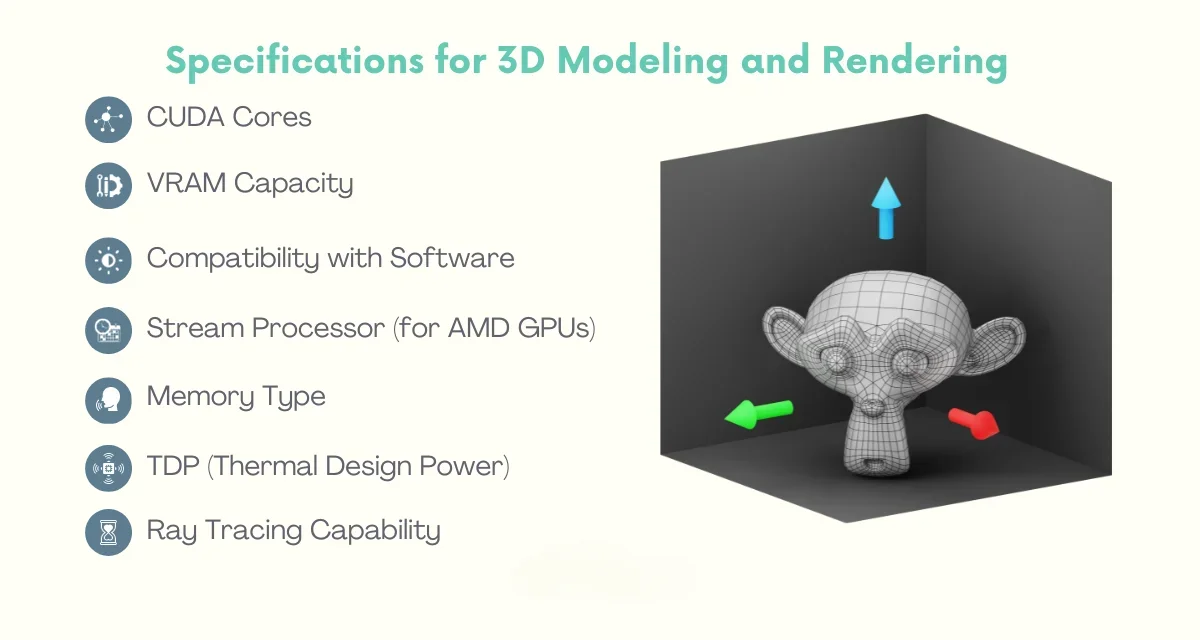
Specification for 3D modeling and rendering encompasses a range of crucial factors that influence the performance and capability of a graphic processing unit (GPU) in handling intricate three-dimensional tasks. These specifications are vital for ensuring a seamless and efficient workflow in the world of 3D design. Let’s explore the essential specifications:
- CUDA Cores: CUDA cores are parallel processing units within a GPU. Higher CUDA core counts often result in improved rendering speeds and better handling of complex 3D models.
- VRAM Capacity: Video Random Access Memory (VRAM) is the memory dedicated to handling graphical data. Adequate VRAM is crucial for managing large textures and intricate 3D scenes without compromising performance.
- Compatibility with Software: Different 3D modeling and rendering software may have varying requirements. Ensuring compatibility with popular software like Blender, Maya, or Cinema 4D is essential for a smooth user experience.
- Stream Processor (for AMD GPUs): Similar to CUDA cores, stream processors are specific to AMD GPUs. A higher count contributes to better parallel processing capabilities, impacting the GPU’s performance in 3D tasks.
- Clock Speed: The clock speed measures how quickly the GPU processes data. A higher clock speed can lead to faster rendering times, making it a crucial consideration for 3D modeling and rendering.
- Memory Type: The type of memory used, such as GDDR6X or HBM2, affects the speed and efficiency of data transfer. Optimal memory types contribute to a smoother rendering experience.
- Bus Width: Bus width determines the amount of data that can be transferred between the GPU and VRAM in a single cycle. A wider bus width often leads to better data transfer rates, positively impacting performance.
- Shader Cores: Shader cores handle tasks related to shading and lighting in 3D graphics. A sufficient number of shader cores ensures realistic lighting effects in rendered scenes.
- TDP (Thermal Design Power): TDP represents the maximum amount of heat a GPU is designed to dissipate. Efficient cooling solutions are crucial to maintaining optimal performance and preventing overheating during prolonged 3D thermal sessions.
- Ray Tracing Capability: Ray tracing enhances the realism of lighting and reflections in 3D models. GPUs with dedicated ray-tracing hardware provide a significant boost in visual quality for realistic scenes.
Top Considerations- GPUs for 3D Modeling and Rendering
CUDA Cores and Parallel Processing
- CUDA Cores: CUDA cores in NVIDIA GPUs handle parallel tasks, enhancing performance for rendering and complex computations by enabling simultaneous calculations. More cores mean faster processing.
- Parallel Processing: CUDA cores in GPUs enable parallel processing, executing multiple operations concurrently for tasks like 3D modeling and rendering, improving efficiency significantly.
VRAM Capacity:
- VRAM (Video Random Access Memory): VRAM, dedicated GPU memory for visual data, is crucial for managing large textures and scenes in 3D tasks. Higher capacity improves performance, especially with complex models and high-resolution textures.
- Importance in 3D work: In 3D modeling and rendering, large datasets are common. Having enough VRAM is crucial for real-time manipulation. Insufficient VRAM can cause performance issues, slowing down or limiting complex 3D projects.
Compatibility with Rendering Software:
- Rendering Software: Different 3D rendering software packages have varying requirements and optimizations for GPU usage. Compatibility ensures that the GPU works seamlessly with the chosen rendering software, providing optimal performance and stability.
- Considerations: When selecting a GPU for 3D work, it’s crucial to check whether it is compatible with the rendering software you intend to use, such as Blender, Autodesk Maya, or Cinema 4D. Compatibility ensures that the GPU’s features and capabilities align with the software’s demands, resulting in an efficient and reliable 3D workflow.
- Optimal Performance: Choosing a GPU that is well-suited for your rendering software ensures that you can leverage the GPU’s capabilities to the fullest, achieving faster rendering times and a smoother overall experience in your chosen 3D application.
Best GPUs for 3D Modeling and Rendering
NVIDIA GeForce RTX 3090
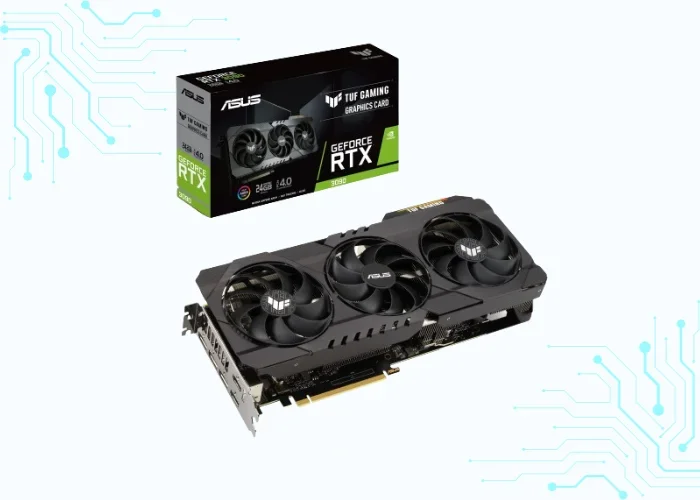
The NVIDIA GeForce RTX 3090 is a high-end graphics card renowned for its exceptional performance in 3D modeling. It boasts a massive 24GB of GDDR6X VRAM, making it capable of handling complex 3D models and textures seamlessly.
With 10,496 CUDA cores, it excels in parallel processing, resulting in faster rendering times. The RTX 3090 is widely favored by professionals who demand top-tier performance for graphic-intensive tasks.
Suggestion
This MotherBoard and CPU are the best for NVIDIA GeForce RTX 3090 GPU, which makes its performance high in 3D modeling and rendering.
- Motherboard: ASUS ROG Strix Z690-A Gaming WiFi D4, MSI MPG Z690 Tomahawk WiFi DDR4
- CPU: Intel Core i9-13900K, AMD Ryzen 9 7950X
| Property | Specification |
|---|---|
| Chipset | NVIDIA GeForce RTX 3090 |
| Memory Interface | 384-bit GDDR6X |
| Clock Speed | Base: 1395 MHz, Boost: 1695 MHz |
| Brand and Model | NVIDIA GeForce RTX 3090 |
| Minimum Power | 750 watts (recommended power supply) |
AMD Radeon RX 6900 XT
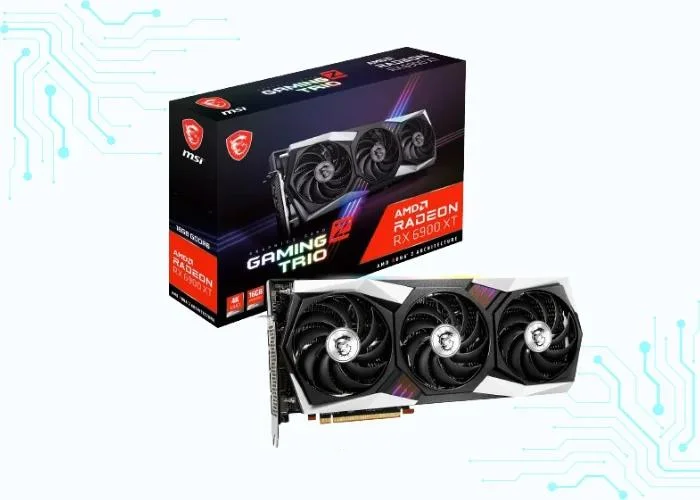
The AMD Radeon RX 6900 XT is another powerhouse in the world of GPUs for 3D modeling. With 16GB of GDDR6 VRAM and 5,120 stream processors, this GPU offers a balance of VRAM capacity and processing power.
It is well-suited for high-quality 3D rendering and modeling tasks. AMD’s commitment to providing competitive alternatives makes the RX 6900 XT a strong choice for users seeking top-notch performance.
Suggestion
This MotherBoard and CPU are the best for AMD Radeon RX 6900 XT GPU, which makes its performance high.
- Motherboard: ASUS ROG Strix X670E-A Pro WiFi, MSI MEG Z790 Tomahawk WiFi
- CPU: AMD Ryzen 9 7950X, Intel Core i9-13900K
| Parameter | Specification |
|---|---|
| Chipset | AMD Radeon RX 6900 XT |
| Memory Interface | 256-bit GDDR6 |
| Clock Speed | Base: 1825 MHz, Game: 2015 MHz, Boost: 2250 MHz |
| Brand and Model | AMD Radeon RX 6900 XT |
| Minimum Power | 300 watts |
NVIDIA Quadro RTX 6000
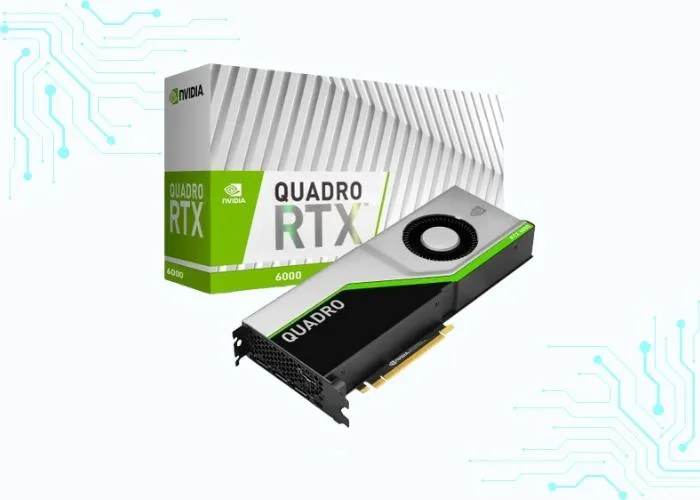
The NVIDIA Quadro RTX 6000 is part of the Quadro series and is specifically designed for professional use in fields like 3D modeling and rendering. Boasting 24GB of GDDR6 VRAM and 4,608 CUDA cores, the Quadro RTX 6000 is engineered for precision and reliability.
Professionals in industries where accuracy is paramount, such as architecture and design, often prefer the Quadro series for its optimized performance and stability.
Suggestion
This MotherBoard and CPU are the best for NVIDIA Quadro RTX 6000 GPU, which makes its performance high.
- Motherboard: ASUS ProArt X670E-Creator WiFi, MSI MEG Z790 Godlike
- CPU: Intel Core i9-13900K, AMD Ryzen Threadripper Pro 5995WX
| Attribute | Specification |
|---|---|
| Chipset | NVIDIA Quadro RTX 6000 |
| Memory Interface | 384-bit GDDR6 |
| Clock Speed | 1,770 MHz (Base) |
| Brand and Model | NVIDIA Quadro RTX 6000 |
| Minimum Power | 295 Watts |
Best GPUs for Rendering
NVIDIA A6000
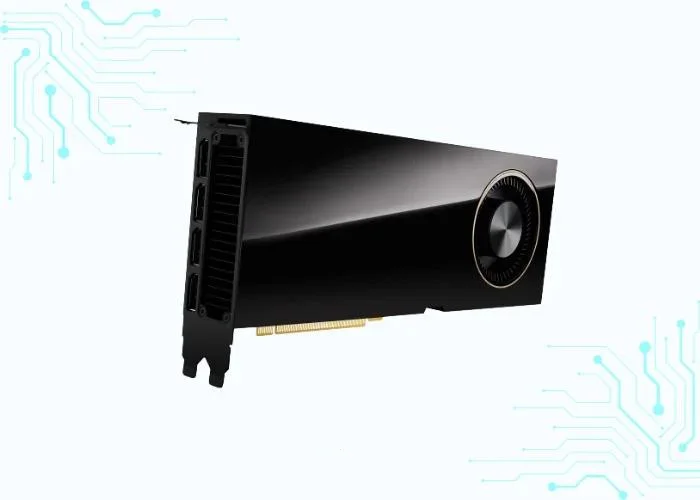
The NVIDIA A6000 is a high-performance graphics card designed for professional workloads, especially rendering. It boasts an impressive 48GB of GDDR6 VRAM, making it well-suited for handling large and complex 3D rendering tasks.
With a substantial 10,752 CUDA cores, the A6000 excels in parallel processing, enhancing its rendering speed and efficiency. As part of NVIDIA’s Quadro series, the A6000 is optimized for professional applications, ensuring stability and reliability in demanding rendering scenarios.
Suggestion
This MotherBoard and CPU are the best for NVIDIA A6000 GPU, which makes its performance high.
- Motherboard: ASUS ROG Strix TRX40-A Gaming WiFi, MSI MEG X590S Carbon EK Waterforce
- CPU: AMD Ryzen Threadripper 3970X, Intel Core i9-13900K
| Attribute | Specification |
|---|---|
| Chipset | NVIDIA Quadro RTX 6000 |
| Memory Interface | 384-bit GDDR6 |
| Clock Speed | 1400 MHz |
| Brand and Model | NVIDIA A6000 |
| Minimum Power | 300 Watts |
AMD Radeon Pro WX 9100
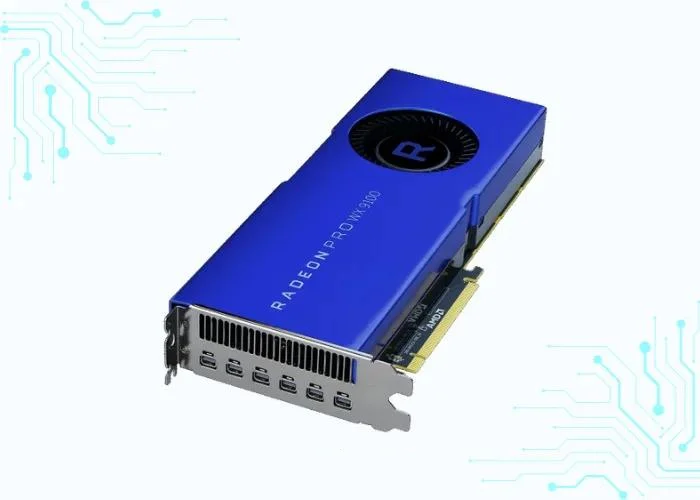
The AMD Radeon Pro WX 9100 is a formidable GPU tailored for professional rendering work. It features 16GB of high-bandwidth memory (HBM2), providing a good balance between memory capacity and speed.
With 2,560 stream processors, the Radeon Pro WX 9100 demonstrates strong parallel processing capabilities, contributing to its prowess in handling intricate rendering tasks. This GPU is well-regarded for its efficiency and stability in professional rendering applications.
Suggestion
This MotherBoard and CPU are the best for AMD Radeon Pro WX 9100 GPU, which makes its performance high.
- Motherboard: ASUS ProArt X670E-Creator WiFi (LGA 1700), MSI MEG X670E Ace WiFi (LGA 1700)
- CPU: AMD Ryzen Threadripper Pro 5995WX, AMD Ryzen 9 7950X
| Parameter | Specification |
|---|---|
| Chipset | AMD Radeon Pro WX 9100 |
| Memory Interface | 2048-bit HBM2 |
| Clock Speed | Base: 1200 MHz, Boost: 1500 MHz |
| Brand and Model | AMD Radeon Pro WX 9100 |
| Minimum Power | 250 Watts |
NVIDIA Titan RTX
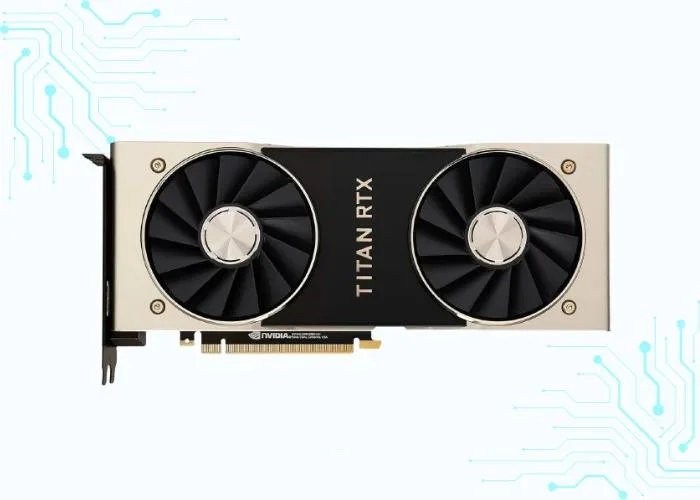
The NVIDIA Titan RTX is a versatile GPU that caters to both gaming and professional workloads, including rendering. With a substantial 24GB of GDDR6 VRAM and 4,608 CUDA cores, it offers significant computing power.
While not explicitly designed for professional rendering like the A6000, the Titan RTX is a popular choice among users who require a GPU capable of handling both gaming and rendering tasks effectively.
Its large VRAM capacity allows for the rendering of complex scenes, and the CUDA cores contribute to efficient parallel processing.
Suggestion
This MotherBoard and CPU are the best for GIGABYTE NVIDIA GeForce RTX 3060 GPU, which makes its performance high.
- Motherboard: ASUS ROG Strix X670E-A WIFI, MSI MEG Z790 Godlike
- CPU: ASUS ROG Strix X670E-A WIFI, MSI MEG Z790 Godlike
| Category | Specification |
|---|---|
| Chipset | TU102 |
| Memory Interface | 384-bit GDDR6 |
| Clock Speed | 1350 MHz base, 1770 MHz boost |
| Brand and Model | NVIDIA Titan RTX |
| Minimum Power | 650 Watts |
Tips for Optimizing GPU Performance
Regular Driver Updates
Updating your GPU drivers is a fundamental practice to optimize performance. Graphics card manufacturers like NVIDIA and AMD frequently release driver updates that include enhancements, bug fixes, and optimizations. These updates can improve compatibility with new software releases, boost overall performance, and address any known issues.
Regularly checking for and installing the latest GPU drivers ensures that your graphics card can leverage the latest advancements and improvements. This simple yet effective step can result in better stability and enhanced performance for various applications, including 3D modeling and rendering software.
Proper Cooling Solutions
Maintaining optimal temperatures is vital for GPU performance and longevity. Graphics cards generate heat during operation, and excessive heat can lead to thermal throttling, reducing performance or causing the GPU to automatically slow down to prevent overheating.
Investing in proper cooling solutions, such as high-quality fans or liquid cooling systems, helps dissipate heat efficiently. Adequate cooling not only ensures consistent performance but also contributes to the overall reliability and lifespan of the GPU. Monitoring temperatures and keeping them within recommended ranges is essential for maximizing performance.
Overclocking Considerations
Overclocking involves adjusting the clock speeds of the GPU to run at higher frequencies than the manufacturer’s default settings. While overclocking can potentially yield increased performance, it requires careful consideration and should be approached cautiously.
Before attempting to overclock your GPU, it’s crucial to understand the limitations and potential risks. Overclocking can lead to higher power consumption and increased heat generation. To mitigate these risks, users should gradually increase clock speeds, monitor temperatures, and ensure stability through stress testing.
Overclocking is not recommended for everyone, especially those unfamiliar with the process. However, for enthusiasts who are comfortable with the technical aspects and understand the potential consequences, it can be a way to extract additional performance from their GPUs.
Comparing GPUs for Different Software
Blender
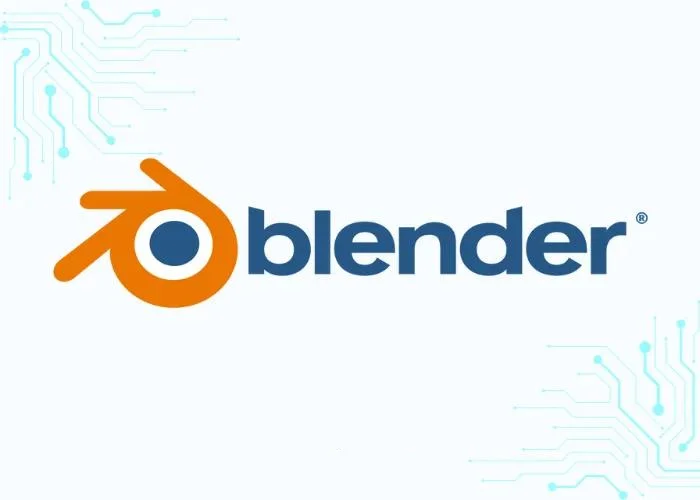
Blender is an open-source 3D creation suite that has gained popularity for its robust feature set and active community. When comparing GPUs for Blender, factors such as CUDA core count, VRAM capacity, and compatibility with Blender’s rendering engines play a crucial role.
- NVIDIA GeForce RTX 3090: With its high CUDA core count and massive VRAM, the RTX 3090 performs exceptionally well in Blender. Its parallel processing capabilities make it suitable for rendering complex scenes and animations.
- AMD Radeon RX 6900 XT: The RX 6900 XT, with its substantial VRAM and efficient stream processor, is a strong contender for Blender users. AMD’s GPUs are known for their competitive performance in various rendering tasks.
Autodesk Maya
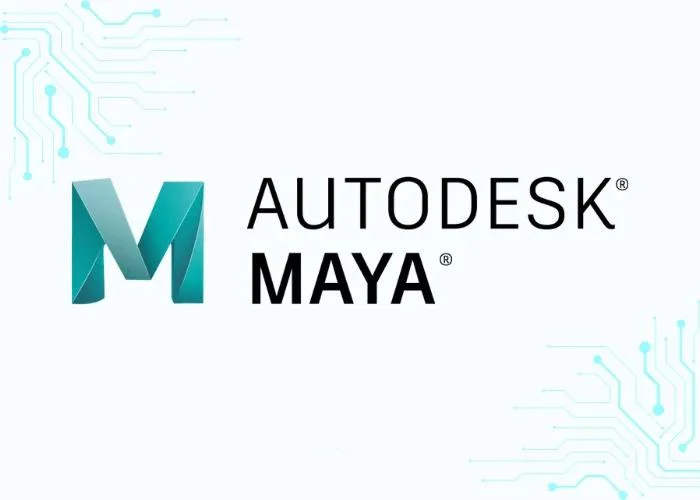
Autodesk Maya is a widely used 3D modeling and animation software in industries such as film, television, and gaming. Maya often relies on GPU performance for tasks like viewport rendering and handling intricate scenes.
- NVIDIA Quadro RTX 6000: The Quadro RTX 6000, designed for professional applications, shines in Maya. Its large VRAM and CUDA cores contribute to the smooth handling of complex 3D models and rendering tasks.
- AMD Radeon Pro WX 9100: The Radeon Pro WX 9100 is a reliable choice for Maya users, offering a good balance of VRAM and stream processors. It ensures stability and efficiency when working with Maya’s demanding workloads.
Cinema 4D
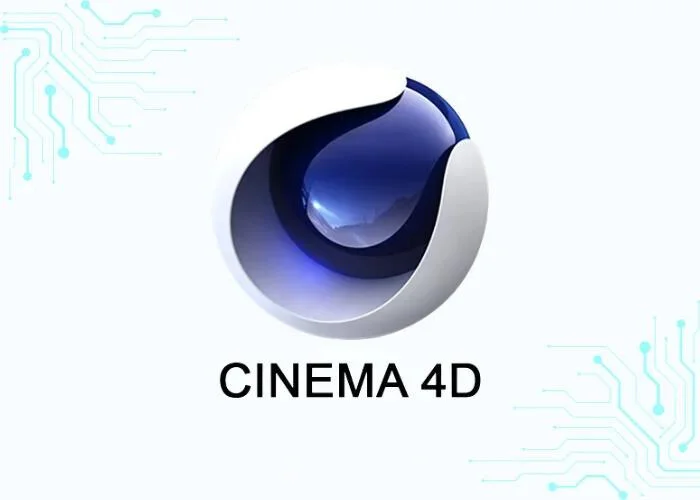
Cinema 4D is known for its intuitive interface and powerful modeling and animation tools. When comparing GPUs for Cinema 4D, factors like single-core performance, GPU acceleration support, and VRAM become important.
- NVIDIA A6000: The A6000’s high CUDA core count and substantial VRAM make it well-suited for Cinema 4D. It excels in handling real-time viewport rendering and complex scenes.
- NVIDIA Titan RTX: The Titan RTX, with its gaming-professional hybrid nature, performs admirably in Cinema 4D. Its ample VRAM and CUDA cores contribute to a smooth and responsive experience.
FAQs
What is the minimum VRAM required for 3D rendering?
The minimum VRAM required depends on the complexity of your 3D projects. For professional rendering, aim for GPUs with at least 8GB VRAM
Can a gaming GPU be used for professional 3D work?
While gaming GPUs can handle some 3D tasks, professional GPUs like NVIDIA Quadro or AMD Radeon Pro are designed for optimal performance in demanding scenarios.
Are higher CUDA core counts always better?
Higher CUDA core counts generally result in better performance, but the overall efficiency depends on the specific tasks and software requirements.
How often should I upgrade my GPU for 3D work?
Consider upgrading your GPU every 2-3 years to stay current with advancements in technology and software demands.
Is ray tracing necessary for 3D modeling?
Ray tracing enhances the realism of lighting and reflections in 3D models. While not essential, it can significantly improve visual quality if your workflow involves intricate lighting scenarios.
How does GPU overclocking affect 3D modeling and rendering performance?
Overclocking can enhance GPU performance, but it should be approached cautiously. It may lead to increased temperatures and potential instability. Users should monitor temperatures and ensure adequate cooling solutions.
What role does VRAM play in handling large 3D models?
VRAM is crucial for storing textures and data related to 3D models. Larger VRAM capacity allows for handling more extensive and detailed models without compromising performance.
Conclusion
In conclusion, choosing the optimal GPU for 3D modeling and rendering is a nuanced decision influenced by factors like CUDA cores, VRAM, and budget.
The NVIDIA GeForce RTX 3090 excels in modeling, offering precision and speed. Specialized GPUs like the NVIDIA A6000 and AMD Radeon Pro WX 9100 stand out for rapid and high-quality rendering in professional applications.
The versatile NVIDIA Titan RTX bridges gaming and professional use seamlessly. Budget-friendly options like the NVIDIA GeForce GTX 1660 Super and AMD Radeon RX 6700 XT offer a balance of affordability and performance.
Future-proofing your investment by staying updated on emerging technologies is crucial for long-term success.




